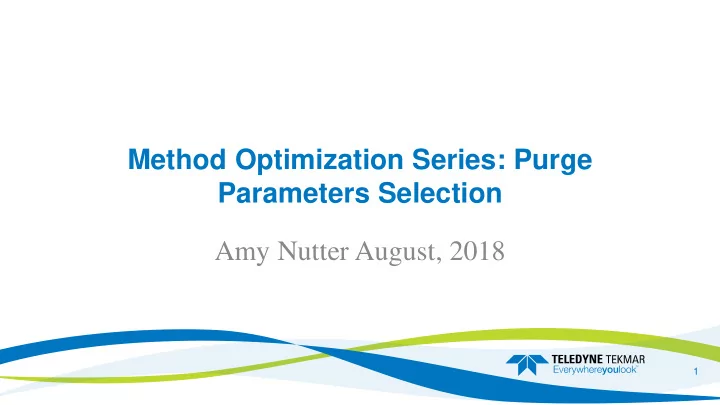

Method Optimization Series: Purge Parameters Selection Amy Nutter August, 2018 1
Overview ■ The fundamentals of purge parameters ■ Purge gas ■ Purge volume ■ Purge flow rate and time ■ In-vial vs. traditional
Purge and trap 101: What is purge and Trap? ■ Purge and Trap is a technique used to improve the sensitivity of volatile samples beyond the capabilities of static headspace. 3
Purge and trap 101: How does purge and Trap work? ■ Purge Equilibrium Theory ■ Compounds migrate out of a concentrated solution and into a dilute solution to reach equilibrium. ■ Purge and Trap ■ The headspace above the sample is constantly replaced with fresh gas, preventing equilibrium from being reached. 4
Static Headspace VS Purge and Trap Purge and Trap Static Headspace
Basic Purge and Trap Set Up – Purge Purge Gas 6-port valve Heated Transfer Line Gas Chromatograph Trap Carrier/Desorb To Vent Gas
Method Parameters Of Purge and Trap ■ Trap selection ■ Sample volume ■ Purge Method (in-vial vs traditional) ■ Purge gas type and volume (time and flow rate) ■ Dry Purge (time and flow rate) ■ Desorb (time and GC flow rate) 7
Method Parameters Of Purge and Trap ■ Trap selection ■ Sample volume ■ Purge Method (in-vial vs traditional) ■ Purge gas type and volume (time and flow rate) ■ Dry Purge (time and flow rate) ■ Desorb (time and GC flow rate) 8
What is the Purge of Purge and Trap? ■ Process through which the VOCs are stripped out of the sample for analysis ■ Purging allows us to collect only the volatile portion of the sample, solid, liquid portions are retained in the glassware and not transferred to GC inlet ■ Facilitates sample concentration without the use of expensive and/or toxic solvents 9
Fundamentals of Purge Gas ■ Must be inert ■ Cannot react with VOCs or any other component of the sample, known or unknown ■ Cannot be combustible and/or unstable ■ H 2 or O 2 ■ Must be free of VOCs ■ Cannot contribute to the total VOC sample collected, creating false positives and/or “dirty” blanks 10
Purge Gas Selection ■ Helium ■ Traditional choice for superior inertness, stability and compatibility with carrier gas for GCMS ■ Is somewhat expensive and occasionally difficult to source ■ Nitrogen ■ Good alternative to Helium thanks to similar inertness and low cost/ability to use generators ■ Is a larger molecule which can have minor affect on purge efficiency and MS vacuum during desorb 11
He to N 2 Purge Gas Comparison – EPA 524.3/4 ■ P&T parameters Helium/Nitrogen 12
He to N 2 Purge Gas Comparison – EPA 524.3/4 ■ GC Parameters ■ 524.3 13
He to N 2 Purge Gas Comparison – EPA 524.3/4 ■ GC Parameters ■ 524.4 14
Results - Gases 15
Results - Midrange 524.3 524.4 16
Results – Late Eluters 17
Purge Gas Conclusions ■ Method requirements were easily met with both purge gases ■ Excellent sensitivity was seen across all ranges of the chromatogram ■ This is due to sensitivity of modern MSDs as well as the use of Helium as the carrier gas 18
Considerations of Purge Volume ■ Flow rate ■ Faster flow means more purge gas in the same length of time ■ Flow too aggressively, can cause pressure issues and/or push compounds too deeply into sorbent bed ■ Purge time ■ Longer times mean more purge gas ■ Purge too long, waste of purge gas and/or push compounds too deeply into sorbent bed 19
Considerations of Purge Volume 20
Purge Volume Comparison – EPA 524 – Parameters 21
Purge Volume Comparison – EPA 524 – Data 22
Purge Volume Comparison – EPA 524 – Data 23
Purge Volume Comparison – EPA 524 – Data 24
Purge Volume Comparison – EPA 524 – Data 25
Purge Volume Comparison – EPA 524 – Data 26
Purge Volume Comparison – EPA 524 – Data 27
Purge Volume Comparison – EPA 524 – Conclusions ■ Purge time can be greatly reduced, resulting in more samples processed during a time period ■ Gases can be affected at higher purge flow rates ■ Heavier compounds can decrease with the shorter purge times ■ Staying within recommended 524.2 parameters – data should look great 28
In-Vial vs. Traditional Purge – 8260 – Parameters 29
In-Vial vs. Traditional Purge – 8260 – Parameters 30
In-Vial vs. Traditional Purge – 8260 – Data 31
In-Vial vs. Traditional Purge – 8260 – Data 32
In-Vial vs. Traditional Purge – 8260 – Data 33
In-Vial vs. Traditional Purge – 8260 – Data 34
In-Vial vs. Traditional Purge – 8260 – Data 35
In-Vial vs. Traditional Purge – 8260 – Data 36
In Vial vs. Traditional Purge – 8260 – Conclusions ■ Method requirements were easily met with both In- Vial and Traditional purge ■ MDLs for In-Vial purge were slightly higher ■ Increased % Accuracy/Recovery for Traditional purge 37
Teledyne Tekmar’s New Online Store! ■ https://store.teledynetekmar.com ■ One convenient stop for all of your Tekmar product needs ■ See pictures and get part numbers 38
Thank You! For more information: Amy.Nutter@Teledyne.com Amy Nutter Website: www.teledynetekmar.com Phone: 1-800-874-2004 TekmarSales@Teledyne.com Sales: Tekmar_IntlSales@Teledyne.com Tekmar_CSC@Teledyne.com Customer Support: Technical Support: TekmarSupport@Teledyne.com Check out our website for all new applications! You can also find us on Twitter, Facebook, and LinkedIn
Recommend
More recommend